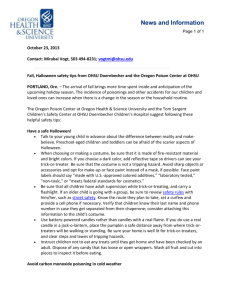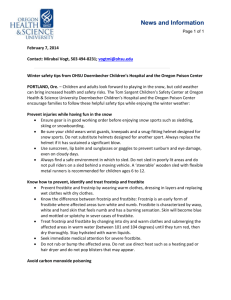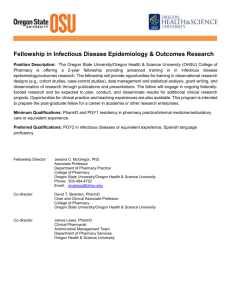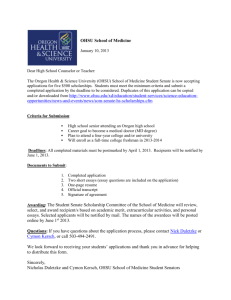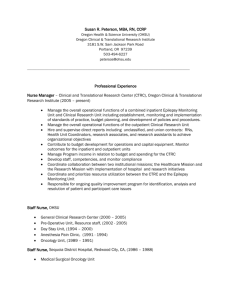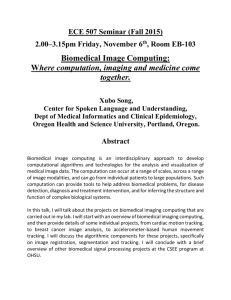Holiday Safety Tips - Oregon Health & Science University
advertisement
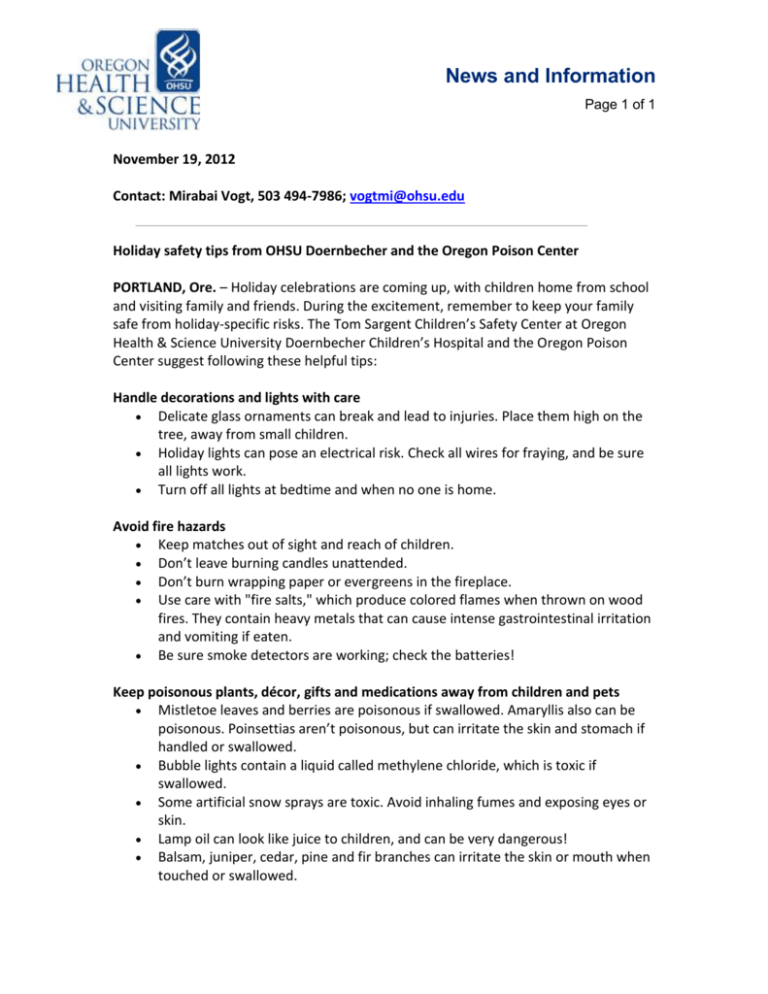
News and Information Page 1 of 1 November 19, 2012 Contact: Mirabai Vogt, 503 494-7986; vogtmi@ohsu.edu Holiday safety tips from OHSU Doernbecher and the Oregon Poison Center PORTLAND, Ore. – Holiday celebrations are coming up, with children home from school and visiting family and friends. During the excitement, remember to keep your family safe from holiday-specific risks. The Tom Sargent Children’s Safety Center at Oregon Health & Science University Doernbecher Children’s Hospital and the Oregon Poison Center suggest following these helpful tips: Handle decorations and lights with care Delicate glass ornaments can break and lead to injuries. Place them high on the tree, away from small children. Holiday lights can pose an electrical risk. Check all wires for fraying, and be sure all lights work. Turn off all lights at bedtime and when no one is home. Avoid fire hazards Keep matches out of sight and reach of children. Don’t leave burning candles unattended. Don’t burn wrapping paper or evergreens in the fireplace. Use care with "fire salts," which produce colored flames when thrown on wood fires. They contain heavy metals that can cause intense gastrointestinal irritation and vomiting if eaten. Be sure smoke detectors are working; check the batteries! Keep poisonous plants, décor, gifts and medications away from children and pets Mistletoe leaves and berries are poisonous if swallowed. Amaryllis also can be poisonous. Poinsettias aren’t poisonous, but can irritate the skin and stomach if handled or swallowed. Bubble lights contain a liquid called methylene chloride, which is toxic if swallowed. Some artificial snow sprays are toxic. Avoid inhaling fumes and exposing eyes or skin. Lamp oil can look like juice to children, and can be very dangerous! Balsam, juniper, cedar, pine and fir branches can irritate the skin or mouth when touched or swallowed. News and Information Page 1 of 1 Be sure all medications have child safety caps and are kept out of reach of children; remind holiday visitors to take this precaution as well. Practice toy safety Select toys that match a child's age, abilities, skills and interest level. Children younger than 3 can choke on small parts contained in toys or games. Take the ‘tube test’ with toys. If a toy or any of its parts can fit through a paper towel cylinder, it is too small for a child under the age of three. Remove strings and ribbons from toys and watch for pull toys with strings more than 12 inches in length; they pose a strangulation hazard for babies. Button batteries are small, and can be extremely dangerous if swallowed. Avoid toys that do not have a screw to keep the batteries in place. Small magnets can cause severe abdominal problems if swallowed. Avoid having them around if you have young children. Store toys in a designated location, such as on a shelf or in a toy chest, and keep older kids’ toys out of reach. Keep your child safe at home and on the go Remember to post the Oregon Poison Center’s number (1 800-222-1222) by home phones and save to cell phones. Block stairs off with a screw-mounted gate to prevent falls in the home and make sure that toilets have a lock when young children are present. If you are traveling this season, have your child’s car seat checked. Call the Tom Sargent Safety Center at OHSU for more information: 503 494-3735. Properly handle and store food Wash hands before and after handling raw food and meats to minimize your chance of contamination from bacteria. Promptly refrigerate dips, eggs, cheeses and meats. Be sure that all holiday drinks containing alcohol are not within reach of children. Thaw your holiday turkey in the refrigerator, allowing one to three days for complete thawing. If time does not allow, immerse the turkey in watertight wrapper in cold water; continue adding ice to avoid turkey reaching room temperature. Remember to remove the liver and gizzards and if you plan to stuff your turkey, do it just prior to roasting. The safest method to determine when the turkey is cooked is to place a meat thermometer inside the thigh muscle or the thickest part of the breast. It should read 180-185 degrees for a normal turkey. For stuffed turkey, place thermometer in the stuffing; the thermometer here should read 165 degrees. News and Information Page 1 of 1 After cooking, remove the stuffing; do not allow the stuffing to cool inside the turkey. About the OHSU Doernbecher Tom Sargent Children’s Safety Center The OHSU Doernbecher Tom Sargent Children’s Safety Center is dedicated to reducing unintentional injuries in children through education and distribution of safety products. For more information, please call 503 418-5666 or visit www.ohsu.edu/childsafety for low cost safety products, educational materials or to find a car seat check-up event in your area. About the Oregon Poison Center The Oregon Poison Center (OPC) is a 24-hour poison emergency management resource for the public and health care professionals serving Oregon, Alaska and Guam. Located on the campus of Oregon Health & Science University, OPC was established by an act of the Oregon State Legislature in 1978 to provide emergency treatment information for patients experiencing a poisoning or toxic exposure. OPC’s doctors and nurses, who are trained in toxicology, handle nearly 60,000 calls a year utilizing professional expertise as well as an extensive variety of computer databases, textbooks and journal articles to determine the appropriate treatment guidelines for patients. Call the poison center hot line number (1 800-222-1222) for all poison emergencies and questions. About OHSU Oregon Health & Science University is the state’s only academic health and research university. As Portland's largest employer with nearly 14,000 employees, OHSU's size contributes to its ability to provide many services and community support activities not found anywhere else in the state. OHSU serves patients from every corner of Oregon and is a conduit for learning for more than 4,300 students and trainees. OHSU is the source of more than 200 community outreach programs that bring health and education services to each county in the state.
